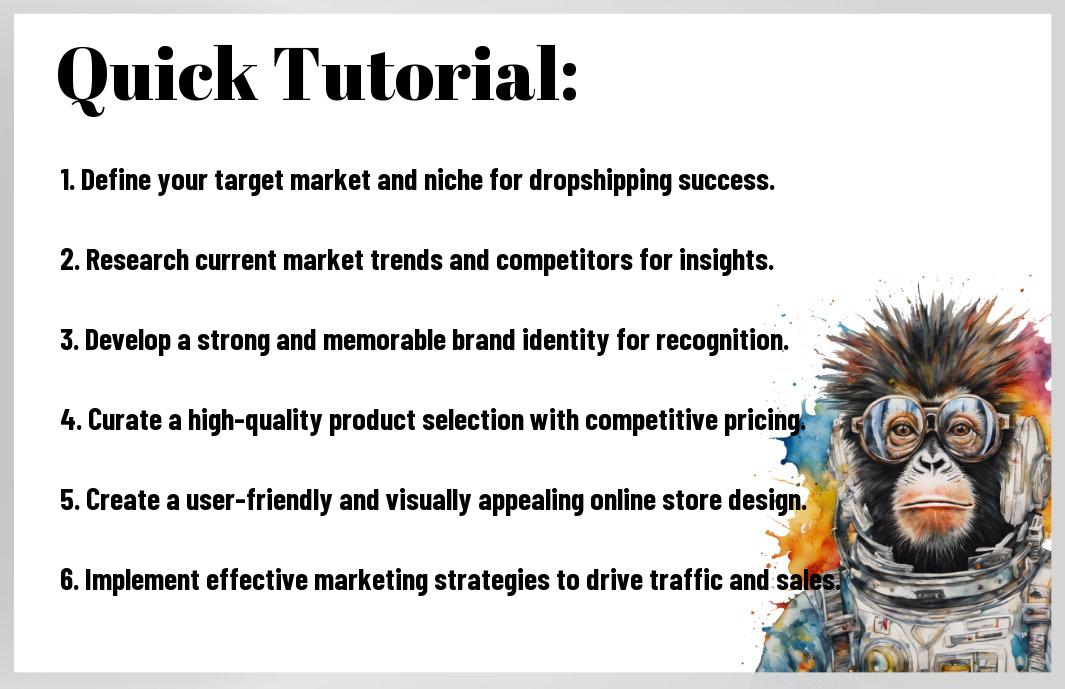10 Essential Elements Of A Successful Dropshipping Brand Strategy
Embark on the journey of mastering the art of dropshipping with these 10 crucial elements that can make or break your brand strategy. In the ever-evolving world of e-commerce, it’s crucial to have a solid foundation for success. From targeted audience research to effective marketing tactics, each element plays a vital role in creating a strong and sustainable brand. Let’s explore into the intricacies of what makes a dropshipping brand strategy stand out from the competition.
Key Takeaways:
- Target Audience: Identifying and understanding your target market is crucial for a successful dropshipping brand strategy.
- Product Selection: Carefully select products with high demand, good profit margins, and low competition to drive sales.
- Brand Identity: Develop a unique brand identity that sets you apart from competitors and resonates with your target audience.
- Customer Service: Provide excellent customer service to build trust and loyalty among your customers.
- Marketing Strategy: Implement a strong marketing strategy using social media, influencer partnerships, SEO, and email marketing to reach a wider audience.
- Quality Suppliers: Partner with reliable suppliers who can provide high-quality products and fast shipping to ensure customer satisfaction.
- Continuous Optimization: Regularly analyze data, track performance, and make necessary adjustments to optimize your dropshipping business for success.
Niche Selection
Target audience analysis
On your journey to building a successful dropshipping brand, understanding your target audience is crucial. Identify who your ideal customer is – their demographics, interests, and pain points. Conduct surveys, research social media insights, and analyze competitor’s customer base to gain valuable insights. Tailoring your marketing strategies to resonate with your target audience will set you apart from your competitors and drive sales.
Market demand research
You need to grasp the Market demand for your chosen niche by analyzing trends, keyword searches, and consumer behavior. Utilize tools like Google Trends, Amazon Best Sellers, and social media analytics to identify Market opportunities and potential competition. Stay updated on emerging trends and fluctuations in demand to adapt your product offerings accordingly.
Market demand research is not a one-time task. Continuously monitor and evaluate Market shifts, consumer preferences, and competitor strategies to stay ahead in your niche. Adaptability and foresight are key to sustaining a successful dropshipping business.


Brand Identity
Unique brand name
If you want your dropshipping brand to stand out in a crowded marketplace, one of the first steps is to create a unique brand name that sets you apart from the competition. Your brand name should be memorable, easy to spell, and relevant to your niche. Avoid using generic names that do not reflect the essence of your brand, as this could dilute your brand identity and make it harder for customers to remember you.
Consistent visual branding
If you want to build a strong brand identity for your dropshipping business, consistent visual branding is key. This includes using the same color scheme, typography, logo, and imagery across all your marketing channels. Consistency helps create a cohesive look and feel for your brand, making it easier for customers to recognize and connect with your brand. By maintaining a consistent visual identity, you can build trust and loyalty with your audience.
Unique brand elements can include a customized logo, a specific color palette, or a distinctive font that sets your brand apart. These elements should be used consistently in all your marketing materials, from your website to your social media posts, to create a cohesive and memorable brand identity.
Quality Suppliers
Reliable producer vetting
Vetting suppliers is a critical step in ensuring the success of your dropshipping business. It involves thoroughly researching and evaluating potential partners to ensure they are reliable, trustworthy, and able to meet your quality standards. Look for suppliers with a track record of timely delivery, good customer service, and high-quality products. It’s vital to establish clear communication channels and set expectations from the outset to avoid any misunderstandings or issues down the line.
Quality control measures
Even with reliable suppliers, implementing quality control measures is crucial to maintaining the standards of your brand. This involves setting clear quality criteria, conducting regular inspections of products, and addressing any issues or defects promptly. By monitoring the quality of your products closely, you can ensure customer satisfaction, build trust in your brand, and reduce the risk of returns or negative reviews.
Quality control measures also include setting up feedback loops with your suppliers to address any recurring issues and continuously improve the quality of your products. By staying proactive and diligent in your quality control efforts, you can differentiate your brand in the competitive dropshipping market and build a loyal customer base.
Compelling Product Offerings
Trending items identification
Now, in order to have compelling product offerings for your dropshipping brand, it is crucial to keep up with the latest trends in the market. Little do you know, identifying trending items can give your brand a competitive edge and attract more customers. Research popular social media platforms, online marketplaces, and industry reports to stay ahead of the curve.
Exclusive product sourcing
Now, when it comes to exclusive product sourcing, it is crucial to find unique items that set your brand apart from competitors. Trending products are a great starting point, but going a step further to offer limited edition items or customized products can truly capture the attention of your target audience. Consider partnering with local artisans or emerging designers to source these exclusive products.
For instance, you could collaborate with a talented jewelry designer to create a one-of-a-kind collection for your brand. This partnership not only adds value to your product offerings but also allows you to establish a unique selling proposition in the market.
Efficient Order Processing
Streamlined Order System
Many successful dropshipping brands attribute their efficiency to a streamlined order system. An organized process for receiving, processing, and fulfilling orders can significantly impact customer satisfaction and operational effectiveness. By automating tasks such as order entry, tracking, and customer communications, brands can ensure timely and accurate order processing.
Swift Fulfillment Procedures
Little delays in order processing can lead to increased customer complaints and loss of trust. An efficient and swift fulfillment procedure is crucial for maintaining a positive reputation and ensuring repeat business. Brands should focus on optimizing warehouse operations, inventory management, and shipping logistics to deliver orders as quickly and accurately as possible.
Customer Relationship Management
Personalized customer communication
All successful dropshipping brands understand the importance of personalized customer communication. By using customer data and insights, you can tailor your communication to each individual customer. This can include personalized product recommendations, special discounts based on past purchases, or even birthday greetings. By making your customers feel valued and appreciated, you can increase customer loyalty and retention.
After-sale service emphasis
If your dropshipping brand wants to succeed, after-sale service emphasis is crucial. This involves providing exceptional customer support post-purchase, addressing any issues or concerns promptly. By offering easy returns, exchanges, and solutions to problems, you can build trust with your customers and enhance their overall experience. Recall, a happy customer is more likely to become a repeat customer and advocate for your brand.
Customer Relationship Management is a key factor in the success of any dropshipping brand. By focusing on personalized customer communication and emphasizing after-sale service, you can build strong relationships with your customers and differentiate your brand from the competition. Implementing these strategies will not only lead to increased customer satisfaction but also help drive long-term success for your dropshipping business.
Data-Driven Decision Making
Analytics tools implementation
Not sure where to start when it comes to making data-driven decisions for your dropshipping brand? You’ll need to implement robust analytics tools to track and analyze crucial performance metrics. Tools like Google Analytics, Facebook Insights, and Shopify’s built-in analytics can provide valuable insights into customer behavior, website performance, and marketing effectiveness.
Performance metrics analysis
Any successful dropshipping brand relies on data-driven decision making. It is necessary to regularly analyze key performance metrics such as conversion rate, customer acquisition cost, and average order value. By closely monitoring these metrics, you can identify trends, spot opportunities for improvement, and make informed decisions to optimize your dropshipping business.
Digital Marketing Strategy
Multi-channel online presence
Once again, a successful digital marketing strategy for a dropshipping brand involves establishing a strong multi-channel online presence. This means being present on various platforms such as social media, marketplaces, and your own website to reach a wider audience.
Targeted advertisement campaigns
Assuming you have identified your target audience, creating targeted advertisement campaigns is crucial for driving traffic and increasing sales. By leveraging tools like Facebook Ads, Google AdWords, and influencer collaborations, you can specifically target individuals who are most likely to be interested in your products.
The key to successful targeted advertisement campaigns lies in creating compelling ad copy and visuals that resonate with your target audience. By analyzing data and adjusting your campaigns accordingly, you can optimize your ad performance and maximize your return on investment.
Scalability and Flexibility
Business model evaluation
To ensure the success of your dropshipping brand, it is necessary to evaluate your business model. The key factors to consider include cost efficiency, customer satisfaction, and operational effectiveness. By analyzing these aspects, you can identify areas that need improvement and make the necessary adjustments to optimize your business performance.
Expansion plan development
Assuming your business model evaluation highlights areas for improvement, it is crucial to develop a comprehensive expansion plan. With a solid plan in place, you can set clear goals for growth and outline the strategies needed to achieve them. By establishing a roadmap for expansion, you can ensure that your brand remains flexible and scalable in response to changing market conditions.
Legal and Financial Framework
Despite the exciting prospects that come with launching a dropshipping business, it is crucial to establish a strong legal and financial framework to ensure long-term success. For a comprehensive guide on building a successful ecommerce or dropshipping business, check out Dropshipping Business: 10 Essential Tips to Creating a….
Legal considerations compliance
While launching on your dropshipping journey, it’s vital to comply with all legal requirements to avoid potential pitfalls. Make sure to obtain all necessary business licenses, sort out tax obligations, and review shipping regulations to ensure a smooth operation.
Financial management setup
Considerations for financial management setup are crucial for the sustainability of your dropshipping brand. Financial stability is key to weathering business uncertainties. Implementing robust accounting practices, monitoring cash flow, and setting up an emergency fund are vital steps. Additionally, establishing relationships with reliable suppliers and negotiating favorable terms can positively impact your bottom line.
To wrap up
Drawing together the 10 crucial elements of a successful dropshipping brand strategy highlights the importance of careful planning, a customer-centric approach, and consistent branding. By focusing on these key areas such as niche selection, supplier relationships, marketing channels, and customer service, dropshipping businesses can create a solid foundation for long-term success. It is crucial to continuously analyze data, adapt to market trends, and stay connected with customers to stay ahead of the competition. Implementing these elements will help businesses build brand trust, establish credibility, and drive growth in the competitive world of e-commerce.
FAQ
Q: What are the 10 vital elements of a successful dropshipping brand strategy?
A: The 10 vital elements of a successful dropshipping brand strategy include niche selection, competitive analysis, brand positioning, website design, product selection, pricing strategy, marketing plan, customer service, fulfillment strategy, and data analysis.
Q: Why is niche selection important in a dropshipping brand strategy?
A: Niche selection is crucial in a dropshipping brand strategy because it helps you target a specific audience, stand out from competitors, and establish yourself as an authority in a particular market segment.
Q: How can competitive analysis benefit a dropshipping brand strategy?
A: Competitive analysis allows you to identify key competitors, understand their strengths and weaknesses, and find opportunities to differentiate your brand and offerings in the market.
Q: What role does brand positioning play in a dropshipping strategy?
A: Brand positioning helps you define how you want your target customers to perceive your brand in relation to competitors, guiding your messaging, product offerings, and overall marketing strategy.
Q: Why is product selection important in a dropshipping brand strategy?
A: Product selection is critical as it impacts customer satisfaction, repeat business, and profitability. Choosing the right products that align with your brand and target market is key to success in dropshipping.
Q: How can a pricing strategy affect the success of a dropshipping brand?
A: A well-thought-out pricing strategy can influence customer buying decisions, perceived value of your products, and overall profitability. Finding the right balance between competitive pricing and profit margins is vital.
Q: What should be included in a dropshipping brand’s marketing plan?
A: A dropshipping brand’s marketing plan should include strategies for social media, content marketing, email marketing, influencer partnerships, and paid advertising to attract and retain customers, drive sales, and build brand awareness.






